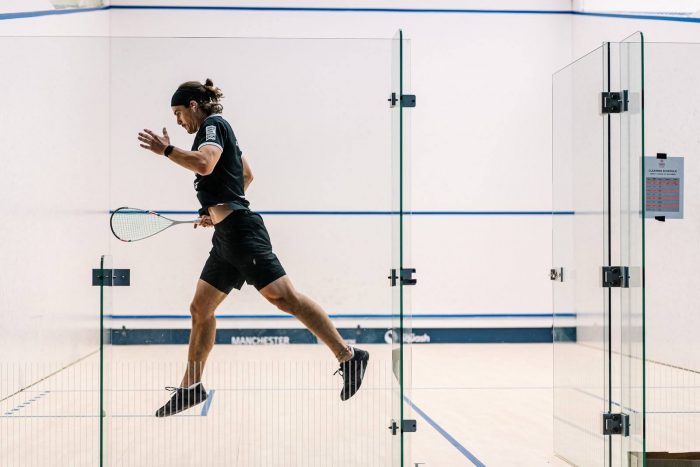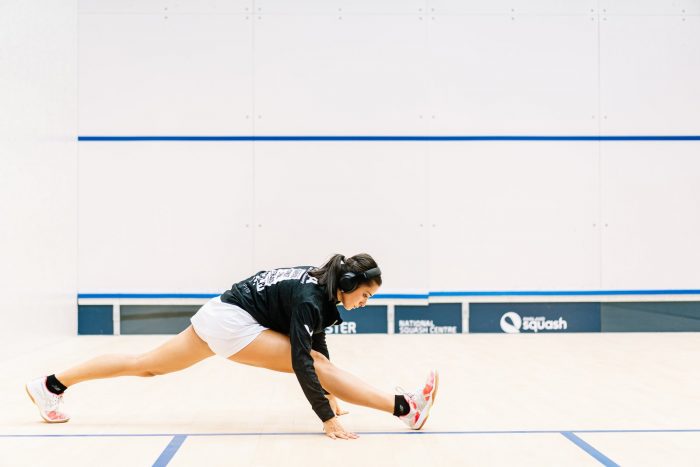‘Fitness’ is comprised of a number of different elements, that all combine together to make up our overall physical profile.
One of the things that makes the sport of squash so challenging, is how heavily weighted the contributions of all these physical attributes are, in so far that even just one weak area can really compromise performance. Developing a comprehensive foundation of all of these different attributes and maintaining a fluid interaction between them, is crucial to optimising the physical aspect of your game.

While there are further sub-divisions that could be made, physical fitness for sport can be divided into 6 main foundation elements: Endurance, Strength, Speed, Agility, Power, and Mobility.
Endurance can be defined as the ability to exercise continuously for extended periods without tiring. A high level of endurance allows us to keep producing and supplying energy to the muscles, to enable them to maintain a high work output with a minimum of performance deterioration.
Strength is the extent to which a muscle/group of muscles can apply force against a resistance. Strength is a precursor to many other physical attributes, and is synonymous with stability in regards to holding a solid, balanced position. Further to the direct performance aspect, strength training also provides significant functional benefits including increased bone, muscle, tendon and ligament toughness, improved joint function, and reduced potential for injury.
Speed is described as the ability to move quickly across the ground or to move limbs rapidly. High levels of speed enable enhanced court coverage and facilitate the ability to get onto balls early to attack, and to be better able to rapidly get into position to relieve pressure when defending.
Agility is often linked closely to speed, and can be defined as the ability to swiftly change body position or direction. Greater agility means being able to react to deception and to change direction rapidly in response to an opponent’s attacks.
Power is the common name often ascribed to what is more accurately called ‘speed-strength’, and is the ability to exert a maximal force in as short a time as possible, as in accelerating, jumping, throwing, and swinging. Power is a product of strength and speed, and is crucial in executing explosive movements to and from the T area, dynamic court coverage, and strong hitting.
Mobility is the capacity of a joint to move through a full range of motion. A full range of motion around a joint allows for reduced discomfort and risk of injury, plus more efficient movement and court coverage – particularly when specific mobility exercises are incorporated as part of a pre-exercise warm-up.
 Unlike many sports where various selections of these physical attributes are emphasised for the ideal physical profile, elite level squash requires each and every one of these aspects of fitness to be at their very peak for a player to be successful.
Unlike many sports where various selections of these physical attributes are emphasised for the ideal physical profile, elite level squash requires each and every one of these aspects of fitness to be at their very peak for a player to be successful.
To better conceptualise this, consider the interactions of all of these elements in the context of a rally: the initial power away from the T provides the primary acceleration, followed by the speed of the feet to get you into position on the ball (and potentially a contribution of agility to change the line of movement if necessary), which precedes the lunge onto the ball and the strength to hold a strong stable position as the shot is played, along with the mobility to get down into a deep lunge position while bringing the swing through the shoulder without hinderance. After the ball has been struck there is the power input again to push you back out of the lunge, and then the foot speed to return you back to the T. On a macro level, the overall ability to keep performing these actions repeatedly throughout the course of the match relies heavily on a high level of endurance.
Fitness in a sporting context then is not just one ‘thing’; it’s composed of a number of different qualities that all need to be trained and optimised, particularly so when aiming for peak performance in such a physically demanding sport as squash.
Gary Nisbet
B.Sc.(Hons), CSCS, NSCA-CPT, Dip. FTST
SquashSkills Fitness & Performance Director
Not sure where to start?
Check out the fitness side of the SquashSkills site for a whole library of exercises and sessions for you to utilise, to help get you into all-round optimum condition to play and compete at your very best possible level.
Find out more